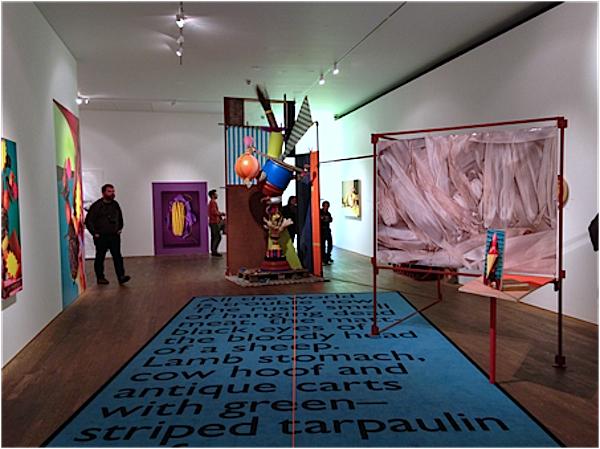
GV Art on Chiltern Street presents Automatic Art: human and machine processes that make art. The subject of this exhibition was already of interest to me as it related to a topic I did this year on my illustration course asking the question, “Are rules creative?” The artists in this exhibition use formulas and obsessive rules mathematically generated by computers. The formulaic processes mean the resulting art becomes something the creator could never have conceived. The technology was impressive and beyond my understanding at this point but personally I’m inspired to learn more and excited to see where this trail of computer-generated artistic thought is going. My favourite piece was William Latham’s Human Mutator2 Reflector image in time (see above photo). Images on the screen move and change based on the movement of the person standing in front of it. The shapes and details become over complex and are easy to get lost in. This piece is fun because it’s interactive…The viewer is invited to play and feel like they’re creating the images themselves.

The Photographer’s Gallery is showing Primrose. This is an interesting exhibition about the history of colour photography in Russia. I love the pre- colour photography images where colour was painted into them. It’s interesting that there’s a clear transition from painting into photography; and an in-between step where the two merge. I think the effect of painting into the photographs makes them feel much more personal and relates to today’s mixed media artists who paint over photographs. I think this effect leaves the artist/photographer with more opportunity to be creative by deciding which parts will have more colour and which parts are left black and white with just the background painted so you get this reverse collage, poster like effect like in the works by Vervana Stepanova. Sometimes the image has been painted on so much that it’s very far from what the original photo was – the photograph was a stencil for what actually became a painting.
(Top Image)
Another exhibition on at the Photographer’s Gallery is Lorenzo Vitturi: Dalston Anatomy. Vitturi uses materials found in market stalls to make sculptures which he then photographs. The exhibition has a fun, bright and inviting atmosphere. The sculptural forms are made from food items and other everyday objects but they take on new meaning when grouped together. The presentation of the photographs themselves is also played with; for example some photos are printed on circular canvases and hung at different heights like bubbles floating through the air which feels playful. Bright contrasting colours are used together in the works like yellow and purple which makes them eye catching and exciting. I feel that in this exhibition the display of the photography was just as important as the photography itself, and hanging the pictures in unusual ways such as on top of each other or mounting them on other objects means that they work as an installation as well.

Lastly at the Photographers Gallery was Didn’t We Have a Lovely Time. It contained photographs of English holiday destinations like Brighton Pier. Plus Mike Perry put together a display of photographs of abandoned shoes; some cracked, broken and covered in shells. This reminded me of an exhibition I took part in last year called Lost Soles which dealt with the same subject: individual shoes going missing from their pair.

House of illustration is a new gallery in Kings Cross right next to the Central St. Martins building. Their first exhibition is Quentin Blake: Inside Stories, which has an entry fee of £5 for students. As you walk into the exhibition you’ll see his expressive illustrations and smile as you’re brought back to your childhood. Each room explores different stories with a summary of them on the wall beside some of Blake’s original illustrations. The descriptions are written by Blake himself and also include some thoughts behind his work: as an illustration student I think this was a valuable exhibition to see as it gave some insight into what it’s like to be an illustrator. I feel that Blake’s illustrations add to how these stories have been read and understood to the point where he’s heavily collaborating with the writers. He describes illustrating as “like directing a play but you also get to design all the scenery and play all the parts.” I think all illustration students should see this exhibition to learn from someone who has excelled in our field and get inside his head a bit; see how he works, how the work in practice sketches changes to what it develops into in the final outcome. Also reading Blake talk about his work is lovely; he’s modest and uses such a likeable tone; “At my own request I was allowed extra pages at the beginning and end of the book”. It’s inspiring to hear from someone who truly does enjoy their work.

At the Royal College of Art, there is a group exhibition of contemporary Chinese artists called Between Ink and Water. I love ink and water as a medium because of the unpredictable and fluid textures of ink spreading on the page. I enjoyed the delicate drawings of plants by Zhu Jiazhong; the dark backgrounds of these pieces allowed them to fade into the distance. Shen Quin experiments with interior and exterior spaces with hard and soft lines that work nicely together. Zheng Zhengmin uses a mix of realism and expressive marks in her drawings of people; the pieces feel free even though some parts are very worked into. Downstairs Wu Xiangyun ‘s pieces feel more like traditional Chinese drawings of plants and could be used as wallpaper designs as they are an enjoyable composition. And lastly, Chang Jin created map like landscapes (see image above).
Words/Photos: Florence Goodhand-Tait

